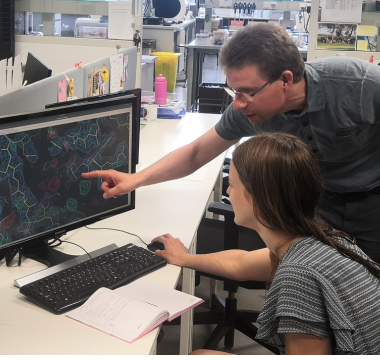My PD Story

Wim Versées, PhD
2025 Impact Award
Designing Nanobodies that Stabilize Dysfunctional Proteins in Parkinson’s
The most common genetic risk factor associated with Parkinson’s disease (PD) lies in the GBA1 gene. Research from the Parkinson’s Foundation genetics study, PD GENEration, has found the GBA1 gene is present in 5-10% of people with the disease. GBA1 provides the instructions to make a protein called glucocerebrosidase (GCase), which plays an important role in the waste recycling compartment of the cell, known as lysosomes. Variants linked to PD produce unstable or less active versions of GCase. As a result, cells lose part of their cleanup ability, leading to a buildup of harmful proteins such as alpha-synuclein.
Wim Versées, PhD, recipient of a Parkinson’s Foundation Impact Award, has discovered a set of small proteins called “nanobodies” that attach to and stabilize these fragile forms of GCase, restoring their functionality in cells where they are needed most.
Most previous research tried to stabilize GCase using small molecule “chaperones”. These compounds could bind and protect the protein but are often attached to the protein’s active site — the very region needed for its normal function, blocking its activity. The nanobodies, by contrast, stabilize GCase by binding to a previously unexplored site far away from the active site, preserving its natural role.
Think of mutant GCase as a fragile vase you want delivered safely to your home. One way to protect it during shipping is to fill it with solid material. That will prevent it from breaking, but once it arrives you can no longer use it to hold flowers. This is what happens when molecules bind the active site. Nanobodies, instead, act by binding or wrapping on the outside of the vase. They keep it intact while still allowing it to hold flowers.

Supported by the Parkinson’s Foundation Impact Award, Dr. Versées, and his lab at the Flanders Institute for Biotechnology in Belgium, will run a battery of biochemical experiments to hone the design of GCase-stabilizing nanobodies. First, he will use state-of-the-art molecular imaging techniques to see exactly where these nanobodies stick to GCase and how it affects the protein. This information will help Dr. Versées and his team identify which set of nanobodies are the best suited for clinical use and how he can further improve their effectiveness.
Collaborating with Steven Ballet, PhD, at Vrije Universiteit Brussel, they will also design so-called “peptidomimetics” that are inspired by the nanobodies and have similar GCase-stabilizing features. Since these are much smaller, they can be more easily delivered to the correct cells in the brain, acting as prototypes for future therapeutics.
Finally, working with Nicoletta Plotegher, PhD, at the University of Padova in Italy, Dr. Versées will test the effectiveness of these nanobodies and peptidomimetics in PD-simulated cells in the lab. Monitoring to what extent the mutant GCase proteins are stabilized and activated with these treatments will validate their potential for future research and their potential as a future treatment.
Excited by this support, Dr. Versées said “Receiving this award from the Parkinson’s Foundation is both a personal honor and a meaningful endorsement of our research. If successful, this strategy could lead to a new class of molecular chaperones that more effectively target the underlying molecular causes of Parkinson’s, opening new therapeutic avenues for people living with GBA1-associated PD.”
Meet more Parkinson’s researchers! Explore our My PD Stories featuring PD researchers.
Related Materials
More Stories
from the Parkinson's community


